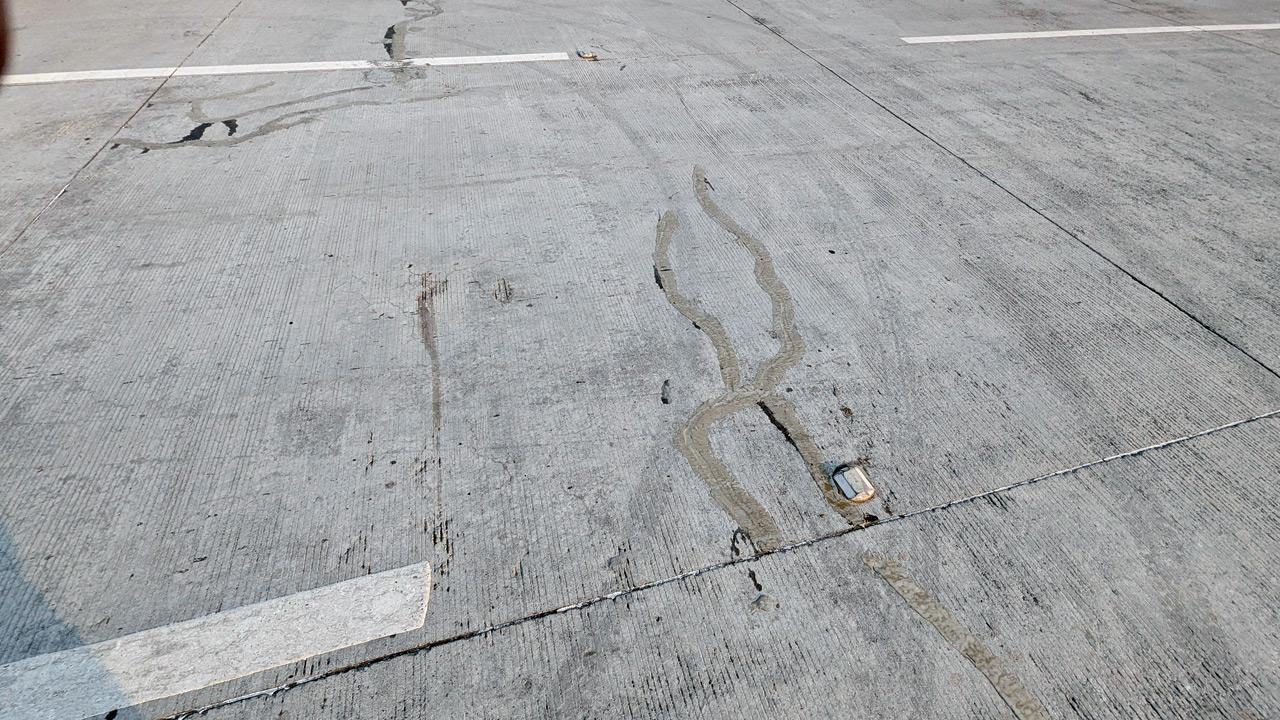
While motorists eagerly await the opening of the final stretch of the Samruddhi Highway from Igatpuri to Mumbai, concerns have emerged over the quality of construction. The cement concrete (CC) road surface between Amane and Shahapur has developed cracks in multiple spots, raising serious questions about the workmanship. This comes just a day after mid-day highlighted how motorists were illegally using the unopened stretch.
A local resident from Shahapur, requesting anonymity, said, “Cracks have appeared in several places along the Amane to Kasara stretch. What’s shocking is that the Amane-Igatpuri section is yet to be officially opened, and yet, the CC road has already started developing cracks.” Sources shared images with mid-day, clearly showing minor cracks on the road surface. Another resident from a village near Bhatsa also provided images of the Amane-Igatpuri stretch, where cracks had reportedly formed.
A section of the unopened expressway near Shahapur with visible cracks
“At some locations, cracks are visible, and in others, repairs seem to have already been done. The authorities must investigate the cause. One possible reason could be illegal vehicular movement, which may have prevented the CC layer from settling properly. Samruddhi Highway is the chief minister’s dream project, and seeing such defects before its official opening is concerning. Action must be taken against the contractor,” said a villager from Shahapur.
Experts weigh-in
mid-day sent the images of the cracks to Girish Jaysing Arekar, council member of the Indian Road Congress (IRC), for his expert opinion. Arekar explained that cracks in newly constructed CC roads could result from several factors, including insufficient curing, which weakens the concrete as it hasn’t properly set in, and poor subgrade preparation, which can cause structural instability.
“Other possible causes include inadequate concrete thickness, improper mix proportions, and temperature variations leading to expansion and contraction. Errors in finishing and the use of low-quality materials during construction can also contribute to premature cracks. A thorough investigation is necessary to determine the root cause,” he said. In some of the images reviewed by mid-day, cracks appeared to have been filled with a white-coloured material. When asked about this, Arekar confirmed that it was an attempt to repair the cracks.
Last leg of highway
Currently, motorists heading toward Nagpur must take the old Mumbai-Nashik Highway up to Igatpuri before merging onto the Samruddhi expressway. The 76-km stretch from Igatpuri to Amane—considered the final leg of the Mumbai-Nagpur Samruddhi Highway—was expected to open by the end of March.
A stretch of the CC road appears to have been hastily filled with white material to cover cracks
Previously, mid-day reported that the construction on this section was nearly complete, with finishing touches such as crash barriers and signage installations underway. MSRDC officials had also stated that work on the Mumbai-end carriageway connecting the Samruddhi Highway to the old Mumbai-Nashik Highway was progressing rapidly. This final stretch features five tunnels and 16 bridges, making it one of the most challenging sections to construct due to the difficult terrain.
Current operational status
As of now, the Samruddhi Highway is operational from Nagpur to Igatpuri. However, motorists travelling from Mumbai to Nagpur—or vice versa—must use the old Mumbai-Nashik Highway until the remaining stretch is opened. Once the 76-km Igatpuri-Amane section becomes operational, motorists will no longer have to navigate the congested Kasara Ghat, significantly reducing travel time and easing traffic on the old highway.
About Samruddhi Highway
The 701-km Samruddhi Expressway is one of Maharashtra’s most ambitious infrastructure projects, connecting economic and agricultural hubs. It passes through three distinct ecological zones: the dry deciduous forests near Nagpur, the central grasslands, and the Western Ghats near Mumbai.












